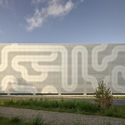31Projects
CEBRA
Architecture Office· Aarhus, Denmark
More about this office
CEBRA is a Danish architecture practice with a growing international portfolio, counting projects across Europe, The Middle East and North America.
CEBRA has 31 projects published in our site, focused on: Residential architecture, Educational architecture, Cultural architecture.
- Projects (31)
- All (73)
·
Save
Sign up to unlock
more of your company's projects














